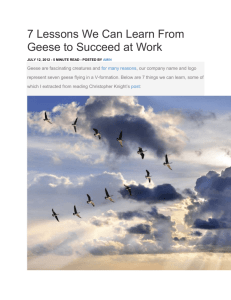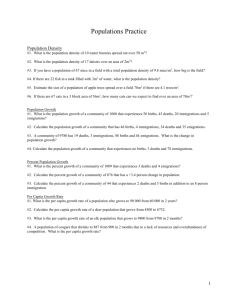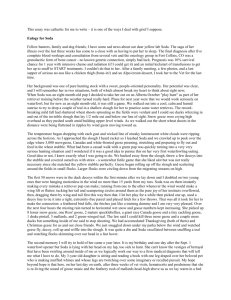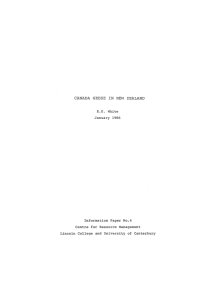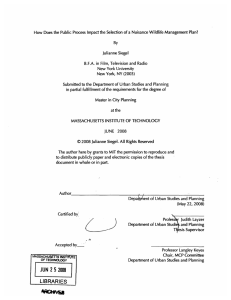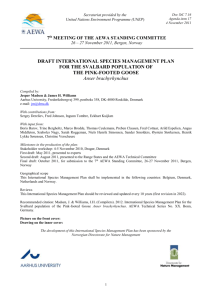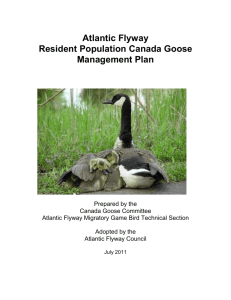070502-03YN031-Summary
advertisement
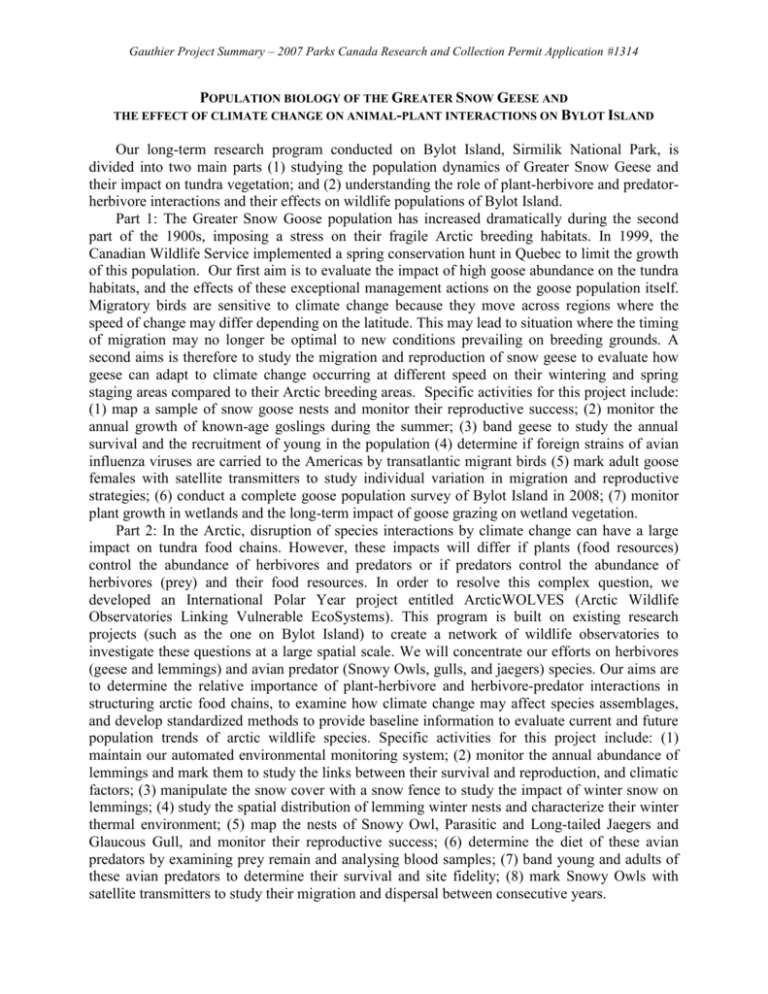
Gauthier Project Summary – 2007 Parks Canada Research and Collection Permit Application #1314 POPULATION BIOLOGY OF THE GREATER SNOW GEESE AND THE EFFECT OF CLIMATE CHANGE ON ANIMAL-PLANT INTERACTIONS ON BYLOT ISLAND Our long-term research program conducted on Bylot Island, Sirmilik National Park, is divided into two main parts (1) studying the population dynamics of Greater Snow Geese and their impact on tundra vegetation; and (2) understanding the role of plant-herbivore and predatorherbivore interactions and their effects on wildlife populations of Bylot Island. Part 1: The Greater Snow Goose population has increased dramatically during the second part of the 1900s, imposing a stress on their fragile Arctic breeding habitats. In 1999, the Canadian Wildlife Service implemented a spring conservation hunt in Quebec to limit the growth of this population. Our first aim is to evaluate the impact of high goose abundance on the tundra habitats, and the effects of these exceptional management actions on the goose population itself. Migratory birds are sensitive to climate change because they move across regions where the speed of change may differ depending on the latitude. This may lead to situation where the timing of migration may no longer be optimal to new conditions prevailing on breeding grounds. A second aims is therefore to study the migration and reproduction of snow geese to evaluate how geese can adapt to climate change occurring at different speed on their wintering and spring staging areas compared to their Arctic breeding areas. Specific activities for this project include: (1) map a sample of snow goose nests and monitor their reproductive success; (2) monitor the annual growth of known-age goslings during the summer; (3) band geese to study the annual survival and the recruitment of young in the population (4) determine if foreign strains of avian influenza viruses are carried to the Americas by transatlantic migrant birds (5) mark adult goose females with satellite transmitters to study individual variation in migration and reproductive strategies; (6) conduct a complete goose population survey of Bylot Island in 2008; (7) monitor plant growth in wetlands and the long-term impact of goose grazing on wetland vegetation. Part 2: In the Arctic, disruption of species interactions by climate change can have a large impact on tundra food chains. However, these impacts will differ if plants (food resources) control the abundance of herbivores and predators or if predators control the abundance of herbivores (prey) and their food resources. In order to resolve this complex question, we developed an International Polar Year project entitled ArcticWOLVES (Arctic Wildlife Observatories Linking Vulnerable EcoSystems). This program is built on existing research projects (such as the one on Bylot Island) to create a network of wildlife observatories to investigate these questions at a large spatial scale. We will concentrate our efforts on herbivores (geese and lemmings) and avian predator (Snowy Owls, gulls, and jaegers) species. Our aims are to determine the relative importance of plant-herbivore and herbivore-predator interactions in structuring arctic food chains, to examine how climate change may affect species assemblages, and develop standardized methods to provide baseline information to evaluate current and future population trends of arctic wildlife species. Specific activities for this project include: (1) maintain our automated environmental monitoring system; (2) monitor the annual abundance of lemmings and mark them to study the links between their survival and reproduction, and climatic factors; (3) manipulate the snow cover with a snow fence to study the impact of winter snow on lemmings; (4) study the spatial distribution of lemming winter nests and characterize their winter thermal environment; (5) map the nests of Snowy Owl, Parasitic and Long-tailed Jaegers and Glaucous Gull, and monitor their reproductive success; (6) determine the diet of these avian predators by examining prey remain and analysing blood samples; (7) band young and adults of these avian predators to determine their survival and site fidelity; (8) mark Snowy Owls with satellite transmitters to study their migration and dispersal between consecutive years.
